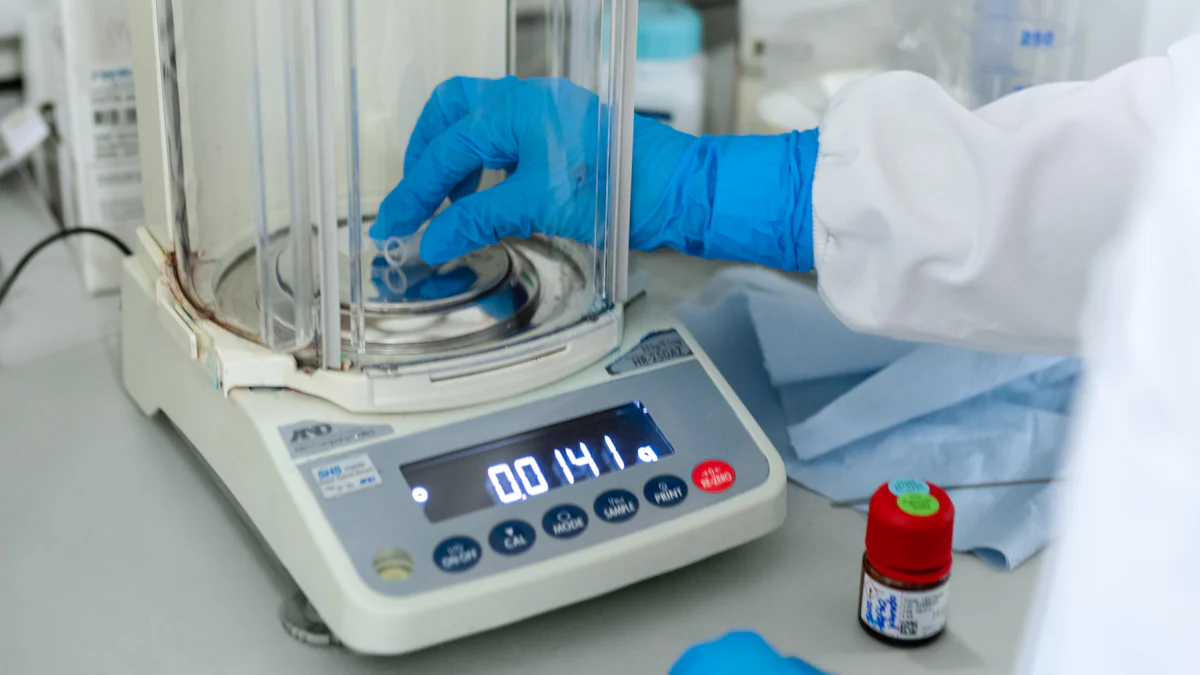
CvD SiC Beschichtungen spielen aufgrund ihrer außergewöhnlichen Eigenschaften eine entscheidende Rolle in der Materialwissenschaft. Diese Beschichtungen zeichnen sich durch eine bemerkenswerte Haltbarkeit aus und gewährleisten eine dauerhafte Leistung in anspruchsvollen Umgebungen. Durch ihre thermische Stabilität können sie extremen Temperaturen ohne Abbau standhalten. Darüber hinaus schützt ihre chemische Beständigkeit Materialien vor Korrosion und Oxidation. Branchen wie Luft- und Raumfahrt, Elektronik und Energie setzen auf diese Beschichtungen, um die Leistung und Lebensdauer kritischer Komponenten zu verbessern. Durch die Kombination von fortschrittlicher Technologie mit einzigartigen Materialeigenschaften revolutionieren CvD SiC Beschichtungen weiterhin moderne Engineering-Anwendungen.
Wichtigste Erkenntnisse
- CvD SiC-Beschichtungen sind bekannt für ihre außergewöhnliche Haltbarkeit, thermische Stabilität und chemische Beständigkeit, so dass sie ideal für anspruchsvolle Umgebungen.
- Branchen wie Luft- und Raumfahrt, Elektronik und Energie setzen auf CvD SiC Beschichtungen, um die Leistung und Lebensdauer kritischer Komponenten zu verbessern.
- Das Verfahren Chemical Vapor Deposition (CvD) gewährleistet eine hohe Reinheit und Gleichmäßigkeit in Beschichtungen, was für Präzisionsanwendungen wesentlich ist.
- Trotz ihrer Vorteile steht die Herstellung von CvD SiC Beschichtungen vor Herausforderungen wie hohen Kosten, langsamen Abscheideraten und der Notwendigkeit einer strengen Kontrolle über die Produktionsbedingungen.
- Emerging-Technologien wie plasmaunterstützte Abscheidung und AI-getriebene Automatisierung werden eingestellt, um die Effizienz und Skalierbarkeit der CvD SiC Beschichtung Produktion zu verbessern.
- Die Vielseitigkeit von CvD SiC Beschichtungen führt zu neuen Anwendungen in Bereichen wie Gesundheits- und Erneuerbare Energien und unterstreicht ihre Anpassungsfähigkeit und ihren Wert.
- Die laufende Forschung und Entwicklung sind entscheidend für die Überwindung der aktuellen Grenzen und die Entriegelung des vollen Potenzials von CvD SiC Beschichtungen in der modernen Technik.
Was sind CvD SiC Beschichtungen?
CvD (Chemical Vapor Deposition) definieren
Chemical Vapor Deposition (CvD) ist ein Verfahren zur Herstellung dünner Filme oder Beschichtungen auf einem Substrat. Es geht um die chemische Reaktion von gasförmigen Vorläufern, die ein festes Material auf die Oberfläche ablagern. Dieses Verfahren gewährleistet eine hohe Reinheit und Gleichmäßigkeit in der resultierenden Beschichtung. Der Prozess tritt typischerweise in einer kontrollierten Umgebung auf, in der Temperatur und Druck sorgfältig geregelt werden. CvD ist weit verbreitet in Industrien, die Präzision und Haltbarkeit erfordern, wie Luft- und Elektronik. Seine Fähigkeit, dichte, fehlerfreie Beschichtungen herzustellen, macht es zu einer bevorzugten Wahl für fortgeschrittene Anwendungen.
Understanding Silicon Carbide (SiC)
Silicon Carbide (SiC) ist eine Verbindung aus Silizium und Kohlenstoff, die für seine außergewöhnlichen physikalischen und chemischen Eigenschaften bekannt ist. Es zeigt eine hohe Härte, Wärmeleitfähigkeit und Beständigkeit gegen Verschleiß und Korrosion. Diese Eigenschaften machen SiC zu einem idealen Material für anspruchsvolle Umgebungen. SiC kann extremen Temperaturen standhalten, ohne seine strukturelle Integrität zu verlieren, so dass es für Hochleistungsanwendungen geeignet ist. Darüber hinaus gewährleistet seine chemische Stabilität den Schutz gegen Oxidation und harte Chemikalien. In Kombination mit CvD verbessern SiC-Beschichtungen die Leistung und Langlebigkeit von Materialien in verschiedenen Branchen.
Anwendungen von CvD SiC Beschichtungen in der Materialwissenschaft

Aerospace Industry
Die Luft- und Raumfahrtindustrie verlangt Materialien, die extreme Bedingungen ertragen können. CvD SiC Beschichtungen verbessern die Leistung von Komponenten, die hohen Temperaturen und mechanischen Belastungen ausgesetzt sind. Diese Beschichtungen schützen Turbinenschaufeln, Motorteile und Bauteile vor Oxidation und Verschleiß. Ihre Leichtigkeit trägt auch zur Kraftstoffeffizienz in Flugzeugen bei. Reflektormaterialien in Satelliten und Raumteleskopen profitieren von der hohen thermischen Stabilität und Präzision von CvD SiC Beschichtungen. Durch die Verbesserung der Haltbarkeit und Zuverlässigkeit spielen diese Beschichtungen eine entscheidende Rolle bei der Entwicklung der Luft- und Raumfahrttechnologie.
Electronics and Semiconductor Industry
In der Elektronik- und Halbleiterindustrie sind Präzision und Zuverlässigkeit unerlässlich. CvD SiC Beschichtungen bieten eine ausgezeichnete Wärmeleitfähigkeit, die Wärme in leistungsstarken Geräten zu verwalten hilft. Sie schützen empfindliche Bauteile vor chemischer Korrosion und physikalischen Schäden. Hersteller verwenden diese Beschichtungen auf Substraten für Mikrochips, Sensoren und optische Geräte. Die Fähigkeit, fehlerfreie, gleichmäßige Schichten herzustellen, sorgt für gleichbleibende Leistung bei elektronischen Anwendungen. Da die Geräte kleiner und komplexer werden, erfüllen CvD SiC Beschichtungen weiterhin die sich entwickelnden Anforderungen der Branche.
Energy Sector
Der Energiesektor profitiert deutlich von den einzigartigen Eigenschaften von CvD SiC Beschichtungen. Diese Beschichtungen verbessern die Effizienz und Lebensdauer von Komponenten in Kraftwerken, einschließlich Turbinen und Wärmetauschern. Ihre Beständigkeit gegenüber hohen Temperaturen und korrosiven Umgebungen macht sie ideal für erneuerbare Energiesysteme, wie Solarpaneele und Windenergieanlagen. In der Kernenergie verbessern CvD SiC Beschichtungen die Sicherheit und Haltbarkeit von Reaktorkomponenten. Durch die Erhöhung der Zuverlässigkeit von Energiesystemen unterstützen diese Beschichtungen den globalen Übergang zu nachhaltigen Energielösungen.
Vorteile von CvD SiC Beschichtungen
Durability and Longevity
CvD SiC Beschichtungen verbessern die Haltbarkeit von Materialien deutlich. Ihre außergewöhnliche Härte schützt Oberflächen vor Verschleiß und mechanischen Beschädigungen, auch bei intensiver Beanspruchung. Diese Funktion macht sie ideal für Anwendungen in Industrien, in denen Bauteile mit konstanter Reibung oder Wirkung konfrontiert sind. Die Langlebigkeit dieser Beschichtungen reduziert den Bedarf an häufigen Austauschen und spart sowohl Zeit als auch Ressourcen. Durch die Beibehaltung der strukturellen Integrität über längere Zeiträume sorgen sie für eine zuverlässige Leistung in kritischen Umgebungen. Viele Branchen verlassen sich auf diese Beschichtungen, um die Lebensdauer ihrer Geräte zu verlängern und die Betriebseffizienz zu verbessern.
Thermal and Chemical Stability
CvD SiC-Beschichtungen weisen eine bemerkenswerte thermische Stabilität auf, so dass sie bei extremen Temperaturen effektiv arbeiten können. Sie widerstehen dem thermischen Abbau und eignen sich für Hochtemperaturanwendungen wie Turbinen und Reaktoren. Ihre chemische Stabilität bietet einen robusten Korrosions- und Oxidationsschutz. Diese Beständigkeit sorgt dafür, dass Materialien durch harte Chemikalien oder Oxidationsmittel nicht beeinflusst werden. Diese Eigenschaften machen CvD SiC Beschichtungen unverzichtbar in Umgebungen, in denen sowohl Wärme als auch chemische Exposition vorherrschen. Ihre Leistungsfähigkeit unter solchen Bedingungen unterstreicht ihren Wert in fortschrittlichen Engineering-Lösungen.
Herstellungsverfahren von CvD SiC Beschichtungen

Überblick über den CvD-Prozess
Die Herstellung von CvD SiC-Beschichtungen beruht auf der Chemical Vapor Deposition (CvD)-Technik. Dieser Vorgang beginnt mit der Einführung gasförmiger Vorläufer in eine Reaktionskammer. Hohe Temperaturen innerhalb der Kammer lösen eine chemische Reaktion aus, wodurch Siliciumcarbid entsteht und sich auf das Substrat abscheidet. Die kontrollierte Umgebung sorgt für Gleichmäßigkeit und Präzision in der Beschichtung. Ingenieure regeln sorgfältig Parameter wie Temperatur, Druck und Gasdurchfluss, um die gewünschte Schichtdicke und Qualität zu erreichen.
Das CvD-Verfahren produziert Beschichtungen mit außergewöhnlicher Reinheit und Dichte. Das Fehlen von Porosität erhöht die mechanische Festigkeit und Haltbarkeit des Materials. Dieses Verfahren ermöglicht auch die Abscheidung dünner, fehlerfreier Schichten, wodurch es für Anwendungen mit hoher Präzision geeignet ist. Die Vielseitigkeit des CvD-Prozesses ermöglicht die Beschichtung komplexer Geometrien und gewährleistet eine umfassende Abdeckung auch auf komplizierten Oberflächen. Diese Eigenschaften machen CvD zu einer wesentlichen Technik in der fortgeschrittenen Werkstofftechnik.
Herausforderungen in der Produktion
Trotz seiner Vorteile stellt die Herstellung von CvD SiC Beschichtungen mehrere Herausforderungen dar. Die hohen Temperaturen, die für den Prozess erforderlich sind, erfordern spezialisierte Geräte und Materialien, die extremen Bedingungen standhalten können. Eine kontrollierte Umgebung während des gesamten Abscheidungsprozesses zu erhalten, erfordert präzise Überwachung und Anpassungen, die die operative Komplexität erhöhen können.
Die Wahl der Vorstufen wirkt sich deutlich auf die Qualität der Endbeschichtung aus. Die Auswahl der entsprechenden Gase und die Sicherstellung ihrer Reinheit ist entscheidend, um optimale Ergebnisse zu erzielen. Verunreinigungen in den Vorläufern können zu Defekten in der Beschichtung führen, was ihre Leistung beeinträchtigt. Zusätzlich ist die Abscheiderate von Siliciumcarbid relativ langsam, was Produktionszeiten und eine Begrenzung der Skalierbarkeit verlängern kann.
Die Kosten bleiben eine weitere wichtige Herausforderung. Die für den CvD-Prozess erforderlichen Geräte und Energie tragen zu hohen Produktionskosten bei. Die Beschleunigung des Prozesses für industrielle Anwendungen erfordert oft erhebliche Investitionen, was kleinere Hersteller weniger zugänglich macht. Forscher erkunden weiterhin Wege, den Prozess zu optimieren, Kosten zu reduzieren und die Effizienz zu verbessern, um diese Einschränkungen zu bewältigen.
Herausforderungen und Einschränkungen
Kosten und Skalierbarkeit
Die Herstellung von CvD SiC Beschichtungen beinhaltet erhebliche Aufwendungen. Die hohen Temperaturen, die für den chemischen Aufdampfprozess erforderlich sind, erfordern fortschrittliche Geräte, die die anfänglichen Investitionskosten erhöhen. Der Energieverbrauch während des Prozesses erhöht die Betriebskosten weiter. Diese Faktoren machen die Technologie für kleinere Hersteller oder Industrien mit begrenztem Budget weniger zugänglich.
Die Skalierung der Produktion von CvD SiC Beschichtungen stellt zusätzliche Herausforderungen dar. Die Abscheiderate von Siliciumcarbid bleibt relativ langsam, was das Volumen der innerhalb eines bestimmten Zeitrahmens erzeugten Beschichtungen begrenzt. Die Erhöhung der Produktionskapazität erfordert oft erhebliche Änderungen an bestehenden Systemen, was zu höheren Kosten führt. Die Hersteller müssen auch dafür sorgen, dass die Skalierung die Qualität oder Gleichmäßigkeit der Beschichtungen nicht beeinträchtigt. Diese Einschränkungen behindern die weit verbreitete Einführung von CvD SiC-Beschichtungen in Industrien, die großtechnische Anwendungen erfordern.
Material- und Prozessbeschränkungen
Die Auswahl der im CvD-Verfahren verwendeten Materialien wirkt direkt auf die Qualität der Endbeschichtung. Gasförmige Vorläufer müssen strenge Reinheitsnormen erfüllen, um Defekte in den abgeschiedenen Schichten zu verhindern. Verunreinigungen in den Vorläufern können zu Inkonsistenzen führen, wodurch die Leistung und Zuverlässigkeit der Beschichtungen reduziert wird. Die Identifizierung und Beschaffung hochwertiger Vorstufen erweist sich oft als herausfordernd und kostspielig.
Der CvD-Prozess selbst hat inhärente Einschränkungen. Eine präzise Kontrolle über Temperatur, Druck und Gasdurchsatz erfordert anspruchsvolle Überwachungssysteme. Jede Abweichung von optimalen Bedingungen kann zu unebenen Beschichtungen oder Strukturfehlern führen. Darüber hinaus bemüht sich der Prozess, bestimmte Substratmaterialien aufzunehmen, die den hohen Temperaturen nicht standhalten können. Diese Einschränkungen begrenzen das Anwendungsspektrum für CvD SiC Beschichtungen, insbesondere in Industrien, die eine unterschiedliche Materialverträglichkeit erfordern.
Forscher erforschen weiterhin innovative Lösungen, um diese Herausforderungen zu bewältigen. Fortschritte bei der Vorläuferentwicklung, der Prozessoptimierung und der Anlagengestaltung sollen Kosten senken und die Anwendbarkeit von CvD SiC Beschichtungen erweitern. Die Überwindung dieser Einschränkungen wird eine entscheidende Rolle bei der Entriegelung des vollen Potenzials dieser Technologie spielen.
Zukunftstrends und Entwicklungen
Emerging Technologies
Das Gebiet der CvD SiC Beschichtungen entwickelt sich weiter mit der Integration von aufstrebenden Technologien. Forscher erforschen fortschrittliche Abscheidetechniken, um die Beschichtungsgenauigkeit und Effizienz zu verbessern. Innovationen wie die plasmaunterstützte chemische Aufdampfung (PECVD) gewinnen an Aufmerksamkeit für ihre Fähigkeit, die Verarbeitungstemperaturen zu senken und gleichzeitig hochwertige Beschichtungen zu erhalten. Diese Fortsätze ermöglichen es, temperaturempfindliche Substrate zu beschichten und das Materialspektrum zu erweitern, das von CvD SiC Beschichtungen profitieren kann.
Automatisierung und künstliche Intelligenz (KI) transformieren auch den Produktionsprozess. KI-getriebene Systeme optimieren Parameter wie Gasdurchflussraten und Temperatureinstellungen und gewährleisten konsistente Ergebnisse. Automatisierung reduziert den menschlichen Fehler und erhöht die Produktionsgeschwindigkeit und macht den Prozess skalierbarer. Diese Technologien ebnen den Weg für eine kostengünstige Fertigung und stellen eine der wichtigsten Herausforderungen in der Industrie dar.
Nanotechnologie ist ein weiterer Bereich, der Innovation vorantreibt. Forscher entwickeln nanoskalige SiC-Beschichtungen mit verbesserten Eigenschaften, wie verbesserte Verschleißfestigkeit und Wärmeleitfähigkeit. Diese Beschichtungen bieten eine überlegene Leistung in Anwendungen, die extreme Präzision erfordern, wie Mikroelektronik und fortschrittliche Optik. Die Integration der Nanotechnologie unterstreicht das Potenzial für CvD SiC Beschichtungen, um den Anforderungen der Ingenieurlösungen der nächsten Generation gerecht zu werden.
Erweiterung von Anwendungen
Die Vielseitigkeit von CvD SiC Beschichtungen führt zu ihrer Annahme in neuen und vielfältigen Branchen. Im medizinischen Bereich werden diese Beschichtungen auf den Einsatz in chirurgischen Instrumenten und Implantaten untersucht. Ihre Biokompatibilität und Verschleißfestigkeit machen sie ideal für die Verbesserung der Haltbarkeit und Sicherheit von medizinischen Geräten. Diese Anwendung zeigt das Potenzial von CvD SiC Beschichtungen zur Verbesserung der Gesundheitstechnologien.
Die Automobilindustrie erkennt auch die Vorteile dieser Beschichtungen. Elektrofahrzeuge (EV) Hersteller verwenden CvD SiC Beschichtungen, um die Leistung von Leistungselektronik und Batteriekomponenten zu verbessern. Die Beschichtungen verbessern das Wärmemanagement und schützen vor chemischem Abbau und tragen zur Effizienz und Langlebigkeit von EV-Systemen bei. Diese Entwicklung unterstützt die wachsende Nachfrage nach nachhaltigen Transportlösungen.
Im Bereich erneuerbarer Energien finden CvD SiC Beschichtungen Anwendungen in fortschrittlichen Solarpaneelen und Windenergieanlagenkomponenten. Ihre Fähigkeit, harte Umweltbedingungen zu widerstehen, sorgt für eine zuverlässige Leistung in erneuerbaren Energiesystemen. Diese Beschichtungen spielen eine entscheidende Rolle bei der Förderung von sauberen Energietechnologien und richten sich an globale Anstrengungen zur Verringerung der CO2-Emissionen.
Die Expansion von CvD SiC Beschichtungen in diese Sektoren unterstreicht ihre Anpassungsfähigkeit und ihren Wert. Da die Industrien weiter innovativ sind, wird die Nachfrage nach Hochleistungsmaterialien wie CvD SiC Beschichtungen nur zunehmen. Dieser Trend unterstreicht die Bedeutung der laufenden Forschung und Entwicklung, um neue Möglichkeiten für diese transformative Technologie zu eröffnen.
CvD SiC-Beschichtungen haben die Materialwissenschaft transformiert, indem sie unübertroffene Haltbarkeit, thermische Stabilität und chemische Beständigkeit bieten. Diese Beschichtungen verbessern die Leistung kritischer Komponenten in allen Branchen, einschließlich Luft- und Raumfahrt, Elektronik und Energie. Ihre Fähigkeit, extremen Bedingungen standzuhalten, sorgt für Zuverlässigkeit in anspruchsvollen Anwendungen. Die laufende Forschung verfeinert ihre Produktionsprozesse weiter und erweitert ihre Anwendungen. Aufstrebende Technologien und innovative Ansätze versprechen, neue Möglichkeiten für dieses fortschrittliche Material zu eröffnen. CvD SiC-Beschichtungen stellen einen Eckpfeiler moderner Technik dar, treiben Fortschritt und gestalten die Zukunft von Hochleistungswerkstoffen.